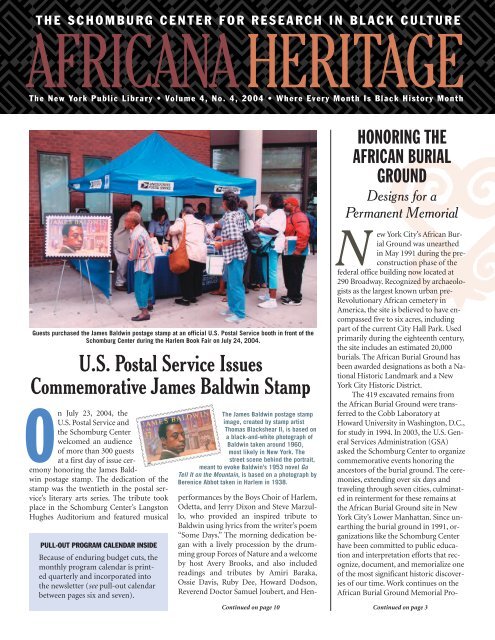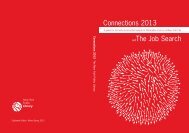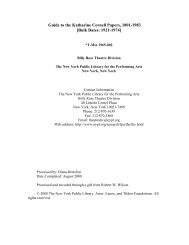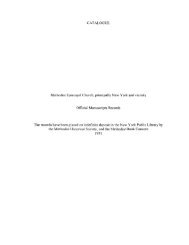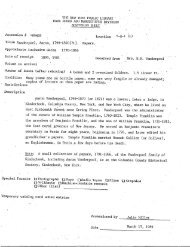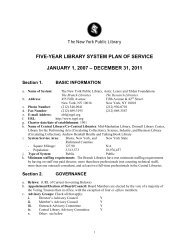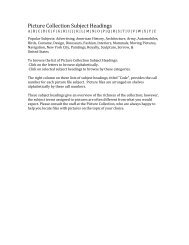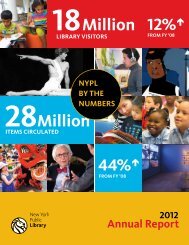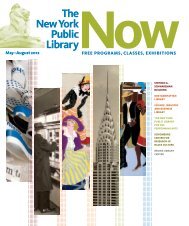U.S. Postal Service Issues Commemorative James Baldwin Stamp
U.S. Postal Service Issues Commemorative James Baldwin Stamp
U.S. Postal Service Issues Commemorative James Baldwin Stamp
Create successful ePaper yourself
Turn your PDF publications into a flip-book with our unique Google optimized e-Paper software.
T H E S C H O M B U R G C E N T E R F O R R E S E A R C H I N B L A C K C U LT U R E<br />
AFRICANA HERITAGE<br />
The New York Public Library • Volume 4, No. 4, 2004 • Where Every Month Is Black History Month<br />
HONORING THE<br />
AFRICAN BURIAL<br />
GROUND<br />
Designs for a<br />
Permanent Memorial<br />
Guests purchased the <strong>James</strong> <strong>Baldwin</strong> postage stamp at an official U.S. <strong>Postal</strong> <strong>Service</strong> booth in front of the<br />
Schomburg Center during the Harlem Book Fair on July 24, 2004.<br />
U.S. <strong>Postal</strong> <strong>Service</strong> <strong>Issues</strong><br />
<strong>Commemorative</strong> <strong>James</strong> <strong>Baldwin</strong> <strong>Stamp</strong><br />
On July 23, 2004, the<br />
U.S. <strong>Postal</strong> <strong>Service</strong> and<br />
the Schomburg Center<br />
welcomed an audience<br />
of more than 300 guests<br />
at a first day of issue ceremony<br />
honoring the <strong>James</strong> <strong>Baldwin</strong><br />
postage stamp. The dedication of the<br />
stamp was the twentieth in the postal service’s<br />
literary arts series. The tribute took<br />
place in the Schomburg Center’s Langston<br />
Hughes Auditorium and featured musical<br />
PULL-OUT PROGRAM CALENDAR INSIDE<br />
Because of enduring budget cuts, the<br />
monthly program calendar is printed<br />
quarterly and incorporated into<br />
the newsletter (see pull-out calendar<br />
between pages six and seven).<br />
The <strong>James</strong> <strong>Baldwin</strong> postage stamp<br />
image, created by stamp artist<br />
Thomas Blackshear II, is based on<br />
a black-and-white photograph of<br />
<strong>Baldwin</strong> taken around 1960,<br />
most likely in New York. The<br />
street scene behind the portrait,<br />
meant to evoke <strong>Baldwin</strong>’s 1953 novel Go<br />
Tell It on the Mountain, is based on a photograph by<br />
Berenice Abbot taken in Harlem in 1938.<br />
performances by the Boys Choir of Harlem,<br />
Odetta, and Jerry Dixon and Steve Marzullo,<br />
who provided an inspired tribute to<br />
<strong>Baldwin</strong> using lyrics from the writer’s poem<br />
“Some Days.” The morning dedication began<br />
with a lively procession by the drumming<br />
group Forces of Nature and a welcome<br />
by host Avery Brooks, and also included<br />
readings and tributes by Amiri Baraka,<br />
Ossie Davis, Ruby Dee, Howard Dodson,<br />
Reverend Doctor Samuel Joubert, and Hen-<br />
Continued on page 10<br />
New York City’s African Burial<br />
Ground was unearthed<br />
in May 1991 during the preconstruction<br />
phase of the<br />
federal office building now located at<br />
290 Broadway. Recognized by archaeologists<br />
as the largest known urban pre-<br />
Revolutionary African cemetery in<br />
America, the site is believed to have encompassed<br />
five to six acres, including<br />
part of the current City Hall Park. Used<br />
primarily during the eighteenth century,<br />
the site includes an estimated 20,000<br />
burials. The African Burial Ground has<br />
been awarded designations as both a National<br />
Historic Landmark and a New<br />
York City Historic District.<br />
The 419 excavated remains from<br />
the African Burial Ground were transferred<br />
to the Cobb Laboratory at<br />
Howard University in Washington, D.C.,<br />
for study in 1994. In 2003, the U.S. General<br />
<strong>Service</strong>s Administration (GSA)<br />
asked the Schomburg Center to organize<br />
commemorative events honoring the<br />
ancestors of the burial ground. The ceremonies,<br />
extending over six days and<br />
traveling through seven cities, culminated<br />
in reinterment for these remains at<br />
the African Burial Ground site in New<br />
York City’s Lower Manhattan. Since unearthing<br />
the burial ground in 1991, organizations<br />
like the Schomburg Center<br />
have been committed to public education<br />
and interpretation efforts that recognize,<br />
document, and memorialize one<br />
of the most significant historic discoveries<br />
of our time. Work continues on the<br />
African Burial Ground Memorial Pro-<br />
Continued on page 3
FROM THE CHIEF<br />
Mark your calendars: Beginning May<br />
2005 and continuing through May 2006<br />
we’ll be celebrating the 80th anniversary<br />
of the founding of the Schomburg Center!<br />
– Howard Dodson, Schomburg Chief<br />
Those of you who missed this year’s<br />
Harlem Book Fair missed an extraordinary<br />
literary event in Harlem’s illustrious<br />
literary heritage. Two full city blocks<br />
(135th Street between Fifth and Seventh<br />
Avenues) were filled from noon until dusk with<br />
publisher and writer booths as well as food, artwork,<br />
and people—thousands of men, women, and<br />
children—book lovers all! Poets and writers on<br />
stages reading their work. Musicians of Africa and<br />
the African Diaspora playing African people’s musics<br />
competed with thousands of conversations as<br />
people met, greeted, and celebrated themselves and<br />
each other through countless encounters with<br />
books—the contemporary literature of the African<br />
world.<br />
And then there were the indoor events: forums<br />
and panel discussions about things literary as well as<br />
life and death issues in African and African Diasporan<br />
communities around the globe. The Langston<br />
Hughes Auditorium, the American Negro Theatre,<br />
and the auditorium at Countee Cullen were filled to<br />
capacity throughout the day. C-SPAN carried the<br />
full day’s offerings from the Langston Hughes Auditorium.<br />
Look for it in reruns.<br />
The day before (July 23), the Schomburg Center<br />
was host to two equally significant events in<br />
Harlem’s literary history. The Center hosted the first<br />
day of issue celebration for the new black heritage<br />
postage stamp honoring Harlemite <strong>James</strong> <strong>Baldwin</strong>.<br />
Avery Brooks, Maya Angelou, Amiri Baraka, Ruby<br />
Dee, and Ossie Davis headlined the commemorative<br />
program before an overflow audience in the<br />
Langston Hughes Auditorium. A complementary<br />
exhibition of photographs by photographer/artist<br />
Ted Pontiflet opened in our Latimer/Edison Gallery.<br />
That evening, Maya Angelou, Chinua Achebe,<br />
Terry McMillan, and Maryse Conde were honorees<br />
in the Harlem Book Fair’s annual Phillis Wheatley<br />
Awards program. Despite torrential rain, the<br />
Langston Hughes Auditorium was packed as Quincy<br />
Troupe and Lynn Whitfield co-hosted a stunning<br />
commemorative event. And there’s more to come!<br />
October 1-3, we are celebrating the first anniversary<br />
of last year’s Rites of Ancestral Return ceremonies<br />
during which we reinterred 419 eighteenthcentury<br />
ancestral remains in New York City’s<br />
African Burial Ground. This year, we pay homage to<br />
the more than 20,000 colonial ancestors who are<br />
buried beneath the streets and buildings covering a<br />
five square block area directly behind New York’s<br />
City Hall.<br />
A more recent ancestor is being honored with a<br />
retrospective exhibition of his work. The art of Romare<br />
Bearden, one of America’s premier visual<br />
artists of the twentieth century, is the subject of this<br />
major retrospective. Originated in the Smithsonian<br />
Institution’s National Gallery last year, it opens in<br />
New York City at the Whitney Museum this month.<br />
A consortium of New York City’s cultural institutions<br />
is sponsoring collaborative events in an effort<br />
to make this tribute a citywide<br />
Bearden festival. The<br />
Schomburg Center’s contribution,<br />
titled Romare<br />
Bearden: From the Archive,<br />
is a complementary exhibition<br />
of items from the<br />
Center’s and collector Russell<br />
Goings’ collections of<br />
Bearden artwork and<br />
memorabilia.<br />
If you want to get a<br />
jump on planning for this year’s Black History<br />
Month celebrations, we recommend that you select<br />
as your theme The African-American Migration Experience.<br />
In addition to the Web site and the National<br />
Geographic Press book we are developing on this<br />
theme, which has a place in every African American’s<br />
history, we are preparing a Black History<br />
Month kit based on the topic to help you get your<br />
programs and activities together. All of these products<br />
will be released by January, thereby giving you<br />
plenty of time to plan your activities. Of course,<br />
Every Month Is Black History Month at the Schomburg<br />
Center. If you haven’t noticed, there’s enough<br />
on our Web site (www.schomburgcenter.org) to<br />
keep you busy and informed twelve months a year.<br />
If you take the first step each month, we’re there to<br />
help you take the second.<br />
Finally, mark your calendars. Beginning May<br />
2005 and continuing through May 2006 we’ll be celebrating<br />
the 80th anniversary of the founding of the<br />
Schomburg Center! The staff is busy planning a<br />
spectacular yearlong celebration for you and the<br />
Center. More on that in the next issue.<br />
2 Africana Heritage • Volume 4, No. 4, 2004 • Where Every Month Is Black History Month
HONORING THE AFRICAN BURIAL GROUND: Designs for a Permanent Memorial<br />
Continued from page 1<br />
ject, which seeks to create a permanent<br />
memorial at the burial ground site. As we<br />
celebrate the first anniversary (October 1-3,<br />
2004) of the African Burial Ground reinterment,<br />
the Schomburg Center is pleased to<br />
publish an overview of the five finalist<br />
memorial design proposals (below). To<br />
view the revised memorial designs, and for<br />
complete information on the African Burial<br />
Ground memorialization process, visit<br />
www.africanburialground.com.<br />
The African Burial Ground: History<br />
Founded in 1625, the colony located on the<br />
southern tip of Manhattan Island that<br />
would become New York City relied heavily<br />
upon the labor of enslaved African workers<br />
to build the new settlement. By the 1630s,<br />
the colony’s African work force lived and<br />
worked uptown, clearing the Haarlem<br />
forest (Harlem) in northern Manhattan.<br />
New York City had become the northern<br />
hub of the slave trade by the 1700s, and a<br />
major slave market opened on an East River<br />
pier at Wall Street in Lower Manhattan. The<br />
city had an enslaved African population of<br />
about 15 to 20 percent during the colonial<br />
era, the largest in the colonies except<br />
Charleston, South Carolina. Archaeologists<br />
estimate that by the end of the eighteenth<br />
century 20,000 enslaved African men,<br />
women, and children had been buried in<br />
the African Burial Ground, which covered<br />
more than five city blocks in Lower<br />
Manhattan when it closed in 1795.<br />
Africans in the Americas<br />
Celebrating the Ancestral Heritage<br />
Friday, October 1 • 11 a.m.<br />
African Burial Ground<br />
Youth Ring Shout Ceremony<br />
South Africa Freedom Park<br />
Reconciliation Ceremony<br />
Vigil<br />
Saturday, October 2 • 11 a.m.<br />
African Burial Ground<br />
Cultural Celebration<br />
Sunday, October 3 • 4 p.m.<br />
Schomburg Center<br />
Vanqui, A Tribute Concert<br />
For information contact (212) 491-2040<br />
or visit www.schomburgcenter.org.<br />
FINALIST MEMORIAL DESIGN PROPOSALS<br />
A design competition is under<br />
way to create a memorial at the<br />
African Burial Ground. The<br />
General <strong>Service</strong>s Administration<br />
and The National Park<br />
<strong>Service</strong> conducted a series of<br />
public forums in June to introduce<br />
five finalist design proposals<br />
for the memorial and to<br />
allow the design finalists to refine<br />
their designs based on<br />
public comments. These refined<br />
designs are on display in<br />
the five boroughs from September<br />
7 through October 8,<br />
2004, and feature the revised<br />
proposals submitted by the design<br />
teams after their review of<br />
public comments. To view the<br />
design proposals in full and to<br />
share your thoughts, visit<br />
www.africanburialground.com<br />
.<br />
1. 2. 3.<br />
4.<br />
5.<br />
1 ANCESTRAL LIBATION CHAMBER<br />
Rodney Leon<br />
“The Ancestral Chamber will<br />
serve to physically, spiritually,<br />
ritualistically, and<br />
psychologically define the<br />
location where the historic<br />
reinterment of remains and<br />
artifacts of 419 Africans took<br />
place.”<br />
2 MEMORIAL DESIGN<br />
Eustace Pilgrim & Christopher Davis<br />
“The path leads viewers seven<br />
feet below street level, on<br />
which they confront the faces<br />
of their ancestors. A sail-like<br />
banner can be heard flapping in<br />
the distance. It reads ‘African<br />
Burial Ground.’”<br />
3 THE SPIRIT CATCHER<br />
GroundWorks<br />
“We maintain that the African<br />
Burial Ground ranks with the<br />
very most significant and<br />
singular sites in the history of<br />
America; the act of<br />
memorializing this site must<br />
not merely pair extreme<br />
intellectual and<br />
design rigor, it must strive to<br />
create an approach that will be<br />
no less than a national<br />
paradigm.”<br />
4 RING OF REMEMBRANCE<br />
Joseph DePace Architect<br />
“We propose a place of cultural<br />
memory, individual<br />
contemplation, family healing,<br />
and community celebration—a<br />
living memorial.”<br />
5 MEMORIAL DESIGN<br />
McKissack & McKissack<br />
“The journey to give each<br />
visitor, young or old, a sense of<br />
the journey taken by the<br />
multitudes of enslaved African<br />
men, women, and children is<br />
the mission of McKissack’s<br />
design for the African Burial<br />
Ground Memorial.”<br />
Africana Heritage • Volume 4, No. 4, 2004 • Where Every Month Is Black History Month 3
H E R I TA G E WATCH<br />
Celebrating<br />
the Work of<br />
Romare<br />
Bearden<br />
Through 2005, The Art of Romare Bearden, a traveling exhibition produced by the National<br />
Gallery of Art, will be on view at a number of national venues, including the Whitney<br />
Museum of American Art in New York City (October 4, 2004 – January 9, 2005). This<br />
fall, more than fifteen New York City institutional partners (see page 9 for a full listing),<br />
including the Schomburg Center, join The Romare Bearden Foundation in honoring the<br />
artist with The Romare Bearden Homecoming Celebration (September 2004 – March<br />
2005). In November, the Center presents Romare Bearden: From the Archive, an exhibition<br />
drawing on the collections of the Schomburg Center and items from Bearden’s personal<br />
library, from the collection of Russell Goings. In anticipation of this unique, citywide<br />
celebration, Africana Heritage is pleased to publish a biography of Bearden, a selection of<br />
artwork from the Schomburg Center’s Art and Artifacts Division, and quotes from Bearden’s<br />
diaries, from the collection of Russell Goings. For a complete list of Romare Bearden<br />
Homecoming Celebration events, visit www.beardenfoundation.org.<br />
R O M A R E B E A R D E N , 1 9 1 1 - 1 9 8 8<br />
Romare Bearden, regarded<br />
as one of the<br />
leading African-American<br />
artists in the United<br />
States, was born in<br />
Charlotte, North Carolina,<br />
on September 2,<br />
1911. Although he grew up in Harlem<br />
where his family lived, reminiscences of<br />
Charlotte, where he spent his childhood<br />
vacations, and the South in general constitute<br />
an important element of his work. As<br />
an adolescent, Bearden spent his summer<br />
vacations with his maternal grandmother,<br />
who ran a boarding house in Pittsburgh in<br />
the 1920s, and it was in Pittsburgh at the<br />
age of twelve that he was first introduced<br />
to painting by a precocious friend named<br />
Eugene.<br />
Bessye J. Bearden, Romare’s mother<br />
and a prominent civic and social figure<br />
during the Harlem Renaissance, had wanted<br />
her only son to become a successful<br />
doctor. With that purpose in mind, Bearden<br />
enrolled in Boston University after<br />
graduating high school and later transferred<br />
to New York University, where he<br />
obtained a B.S. in mathematics in 1935.<br />
While on campus, however, Bearden started<br />
drawing for the college humor magazine,<br />
as well as contributing a regular political<br />
cartoon to The Baltimore<br />
Afro-American, an influential weekly newspaper.<br />
The year of his graduation, he<br />
joined the Harlem Artists Guild, a Work<br />
Projects Administration program for unemployed<br />
black artists during the Depression,<br />
and the “306 Group,” an association<br />
of black artists living in Harlem. The following<br />
year he enrolled at the Art Students<br />
League, where he studied life drawing and<br />
painting with the German exiled artist<br />
George Grosz. By this time, Bearden had<br />
completely cast aside his medical ambitions.<br />
In 1938, he began working for the New<br />
York City Department of Social <strong>Service</strong>s as<br />
a case worker. He continued his artistic endeavors<br />
and rented a studio at 125th Street,<br />
right above the artist Jacob Lawrence. The<br />
artistic community in Harlem was at the<br />
time a very closely-knit group of people,<br />
and Bearden knew many of them. While he<br />
was growing up, Duke Ellington, a close<br />
friend of the family, Fats Waller, and the<br />
lyricist Andy Razaf, among others, used to<br />
drop by regularly to visit with his mother.<br />
Bessye Bearden was an active promoter of<br />
4 Africana Heritage • Volume 4, No. 4, 2004 • Where Every Month Is Black History Month
CLOCKWISE FROM FAR LEFT<br />
Romare Bearden at work in his studio<br />
in Long Island City, New York.<br />
Photograph by Manu Sassoonian.<br />
Photographs and Prints Division,<br />
Schomburg Center for Research in Black<br />
Culture.<br />
Slave Ship, 1972. Art and Artifacts<br />
Division, Schomburg Center for<br />
Research in Black Culture.<br />
Black Manhattan, 1969. Art and<br />
Artifacts Division, Schomburg Center for<br />
Research in Black Culture.<br />
Jammin at the Savoy, 1981. Art and<br />
Artifacts Division, Schomburg Center for<br />
Research in Black Culture.<br />
Untitled (<strong>Commemorative</strong> Collage for<br />
the Fiftieth Anniversary of the<br />
Schomburg Center), 1975. Art and<br />
Artifacts Division, Schomburg Center for<br />
Research in Black Culture.<br />
“<br />
There are times when I am<br />
standing in front of the board and<br />
something takes completely over<br />
my being and I become an instrument<br />
through which images and<br />
creative forces guide me. During<br />
those moments, I’m completely<br />
vulnerable. I have to surrender my<br />
soul to that mysterious force.<br />
” —ROMARE BEARDEN<br />
Continued<br />
young artists, among them, the actor<br />
Canada Lee, who was one of her protégés.<br />
Bearden also became acquainted with the<br />
painter and muralist Aaron Douglas,<br />
sculptor Augusta Savage, and artists in the<br />
“306 Group”: Charles Alston, Henry<br />
Barnarn, Gwendolyn Bennett, Ernest<br />
Crichlow, Norman Lewis, the composer<br />
Frank Fields, Joshua Lee, and Stuart Davis,<br />
among others.<br />
Romare Bearden’s career as a painter<br />
was launched in 1940 with an exhibition<br />
of his earlier work as a student at the studio<br />
of his friend Addison Bates. His work<br />
in the 1940s, primarily watercolors of<br />
southern scenes on brown paper, were included<br />
in various exhibitions at galleries<br />
and museums.<br />
Bearden was drafted into the U.S.<br />
Army in 1942 and served during World<br />
War II in a segregated unit, the 372nd Infantry<br />
Regiment. Discharged in 1945 at the<br />
end of the war, he resumed his duties as a<br />
case worker for the Department of Social<br />
<strong>Service</strong>s the following year. In 1950, he<br />
went to Paris on the GI Bill to study philosophy<br />
at the Sorbonne. There, he met the<br />
great French artists Constantin Brancusi<br />
and Georges Braque, as well as prominent<br />
American émigrés such as Richard Wright<br />
and <strong>James</strong> <strong>Baldwin</strong>.<br />
Bearden left France after his GI benefits<br />
were exhausted and returned to<br />
Harlem with one purpose in mind: to earn<br />
enough money to go back to Paris. During<br />
this period his style matured: his work became<br />
more abstract, his colors more solid<br />
and vibrant. He also switched from watercolors<br />
to oil. But in spite of the heightened<br />
quality of his work and his growing popularity<br />
in New York, the contradictions and<br />
the repressive nature of a racially segregated<br />
culture destroyed his confidence in the<br />
financial prospects of his art and, ultimately,<br />
in his art itself. In search of a better financial<br />
alternative, he turned to song writing,<br />
although without conviction, and in<br />
1952 he resumed work for the Department<br />
of Social <strong>Service</strong>s.<br />
Bearden’s marriage to Nanette Rohan in<br />
1954 renewed his commitment to painting.<br />
on page 9<br />
Africana Heritage • Volume 4, No. 4, 2004 • Where Every Month Is Black History Month 5
A R O U N D T H E<br />
S C H O M B U R G C E N T E R<br />
QBR’s Harlem Book Fair<br />
An extraordinary success this year, the sixth annual<br />
Harlem Book Fair took place along West 135th Street<br />
and featured books, authors, music, panel discussions,<br />
award ceremonies, and spoken work over a<br />
long weekend in July. Events outside and inside the<br />
Schomburg Center are featured here.<br />
Young readers handed out flyers in front<br />
of a booth featuring children’s books.<br />
More than 40,000 people attended the fair, which featured some 250 exhibitor booths.<br />
Ilyasah Shabazz (Growing Up X) and Susan Fales-Hill (Always Wear Joy) participated<br />
in the panel discussion Narratives of a Black Life: Memoir & Biography<br />
with Victor Woods (A Breed Apart: A Journey to Redemption) and Stephanie<br />
Stokes Oliver (Song for My Father: Memoir of an All-American Family).<br />
Amiri Baraka, one of many writers who attended the<br />
weekend events, took in the fair.<br />
Maya Angelou, a<br />
Wheatley Book Award<br />
honoree (with Chinua<br />
Achebe, Maryse<br />
Conde, and Terry<br />
McMillan), spoke before<br />
an audience in<br />
the Schomburg Center’s<br />
Langston Hughes<br />
Auditorium.<br />
Awardees were recognized<br />
for “creating<br />
literary work that<br />
transcends culture,<br />
boundary, and perception.”<br />
Juan Williams, author of This Far by Faith, participated in The Spirituality of<br />
Our Nation, a Harlem Book Fair panel discussion at the Schomburg Center.<br />
Other panelists included Derrick Bell (Silent Covenants: Brown v. Board of<br />
Education and The Unfulfilled Hopes for Racial Reform), Dr. Arlene Churn<br />
(The End Is Just the Beginning: Lessons in Grieving for African Americans),<br />
and Jawanza Kunjufu (Countering the Conspiracy to Destroy Black Boys).<br />
6 Africana Heritage • Volume 4, No. 4, 2004 • Where Every Month Is Black History Month
The University of Kansas honored photographer Gordon Parks with an<br />
achievement award in June. The ceremony, which took place at the<br />
Schomburg Center, was organized by residents of Parks’s home state,<br />
including Kansas Governor Kathleen Sebelius (second from right).<br />
The cast of Caroline, Or Change came to the<br />
Schomburg Center in July for a panel discussion<br />
about the musical, which is set in Louisiana early<br />
in the civil rights movement.<br />
Tonya Pinkins, who plays Caroline, and Anna<br />
Deveare Smith, who served as moderator for the<br />
evening, discussed the show.<br />
The U.S. General <strong>Service</strong>s Administration and the National<br />
Park <strong>Service</strong> sponsored a series of New York City workshops<br />
and public forums in May and June to discuss designs<br />
for an exterior memorial for the African Burial Ground<br />
in Lower Manhattan. The meetings took place in all five boroughs.<br />
At the workshop pictured here, Tara Morrison and<br />
George McDonald, representatives from the National Park<br />
<strong>Service</strong>, make a presentation at Medgar Evers College,<br />
CUNY, in Brooklyn, and take feedback from participants.<br />
Africana Heritage • Volume 4, No. 4, 2004 • Where Every Month Is Black History Month 7
NEWFROM THE SCHOMBURG CENTER<br />
Schomburg<br />
COMING IN JANUARY!<br />
In Motion: The African-American<br />
Migration Experience<br />
The Web site<br />
Four Hundred Years of African Americans<br />
on the Move<br />
From Africa to the Rural South<br />
From the Rural South to the Nation<br />
The peoples, the places, and the events that<br />
shaped the past, the present, and the future<br />
of the 35 million African Americans In<br />
Motion<br />
Discover their extraordinary stories<br />
with In Motion: The African-American Migration<br />
Experience, a one-of-a-kind Web site<br />
for students, teachers, scholars, and the general<br />
public. The Web site includes 16,500<br />
pages of essays, books, articles, and manuscripts,<br />
8,300 images, lesson plans, maps,<br />
music, and more.<br />
In Motion: The African-American Migration Experience<br />
Web site was made possible by a grant from the<br />
Congressional Black Caucus administered by the Institute<br />
of Museum and Library <strong>Service</strong>s.<br />
The Book<br />
Look for In Motion: The African-American<br />
Migration Experience, a landmark work of<br />
cultural history published by the Schomburg<br />
Center and National Geographic (with<br />
150 full-color and black-and-white illustrations,<br />
four maps, and 224 pages).<br />
AND COMING IN FEBRUARY!<br />
The Black History Month Kit<br />
The essays, books, images, lesson plans,<br />
and maps from In Motion: The African-<br />
American Migration Experience Web site<br />
will be available for Black History Month<br />
in condensed form for use by schools and<br />
associations.<br />
E XH IB ITIO N S<br />
September 9 – October 24, 2004<br />
Blacks and the United States Constitution<br />
Blacks and the United States Constitution<br />
examines the pivotal role of race in American<br />
Constitutional history, the black presence<br />
in American<br />
society, the dynamics<br />
of race relations<br />
in the United States,<br />
and the history of<br />
black freedom<br />
struggles. Highlights<br />
include proceedings<br />
of nineteenth-century<br />
black conventions,<br />
David Walker’s<br />
fiery Appeal<br />
using natural rights<br />
philosophy to justify slave violence in pursuit<br />
of freedom, Secretary of State William<br />
H. Seward’s signed certificate attesting to<br />
the ratification of the Fourteenth Amendment,<br />
and the Supreme Court’s formal<br />
judgment in Brown v. Board of Education.<br />
Latimer/Edison Gallery<br />
November 5, 2004 – January 7, 2005<br />
Romare Bearden: From the Archive<br />
Drawing on the collections of the Schomburg<br />
Center for Research in Black Culture<br />
and paintings, sketches, and items from<br />
Bearden’s personal library, from the collection<br />
Russell Goings, Romare Bearden: From<br />
the Archive explores Bearden’s approaches<br />
to developing his craft, as well as selected<br />
non-traditional pieces among Bearden’s<br />
works.<br />
This exhibition is a component of The<br />
Romare Bearden Homecoming Celebration<br />
(September 2004 – March 2005), with multidisciplinary<br />
citywide programs and events<br />
occasioned by the presentation of the National<br />
Gallery of Art exhibition The Art of<br />
Romare Bearden at the Whitney Museum of<br />
American Art.<br />
Exhibition Hall<br />
November 18 – December 31, 2004<br />
hiphoproots: origins and impact<br />
In celebration of Hip-Hop Month, the Hip-<br />
Hop Archive Project presents an exhibition<br />
focusing on the historical value of hip-hop<br />
and its preservation. The exhibition will<br />
feature hip-hop artifacts from the collections<br />
of Cold Crush Brother A.D. Harris<br />
and photographer Joe Conzo.<br />
Save The Date!<br />
Thursday, November 4 • 6 p.m.<br />
Romare Bearden: From the Archive<br />
A Members’ Only Preview<br />
Join the Schomburg Center for the opening<br />
of Romare Bearden: From the Archive,<br />
an exhibition drawing on the collections<br />
of the Schomburg Center and collector<br />
Russell Goings. Romare Bearden: From the<br />
Archive is occasioned by the presentation<br />
of the National Gallery of Art exhibition<br />
The Art of Romare Bearden at the Whitney<br />
Museum (October 2004 – January 2005)<br />
and is a component the Romare Bearden<br />
Homecoming Celebration, September<br />
2004 – March 2005, a New York citywide<br />
celebration honoring one of America’s<br />
foremost artists.<br />
Center programs and exhibitions<br />
are supported in part by the City of New<br />
York, the State of New York, the Office of the<br />
Borough President of Manhattan, the New<br />
York State Black, Puerto Rican and Hispanic<br />
Legislative Caucus, the Rockefeller Foundation<br />
Endowment for the Performing Arts,<br />
The Coca-Cola Foundation, New York Life<br />
Foundation, Annie E. and Sarah L. Delaney<br />
Charitable Trusts, J.P. Morgan Chase & Co.,<br />
and the Edler Hawkins Foundation.<br />
The Schomburg Center is a member of the<br />
Harlem Strategic Cultural Collaborative<br />
(HSCC).<br />
8 Africana Heritage • Volume 4, No. 4, 2004 • Where Every Month Is Black History Month
H E R I TA G E WATCH<br />
Romare Bearden, continued from page 5<br />
Convinced, however, of the shortcomings of<br />
his formal artistic training, Bearden became<br />
involved in new experiments with color and<br />
a meticulous and in-depth study of the great<br />
masters: Rembrandt, Monet, Veronese, and<br />
Grotto, among others. By the end of the<br />
1950s, his style had become almost exclusively<br />
abstract and non-objective.<br />
The Beardens moved in 1954 to an<br />
artist’s loft on Canal Street,<br />
which became an informal rendezvous<br />
for struggling young artists and<br />
some of Bearden’s more well known acquaintances.<br />
There, in 1963, Bearden and a<br />
group of artists that included Charles Alston,<br />
Alvin Hollingsworth, Norman Lewis,<br />
and Hale Woodruff constituted the “Spiral<br />
Group,” dedicated, in part, to encouraging<br />
galleries to exhibit the works of younger, talented<br />
black artists. With that same objective<br />
in mind, the Cinque Gallery was launched<br />
seven years later by Bearden, Ernest<br />
Crichlow, and Norman Lewis. It was while<br />
working on a “Spiral Group” project to present<br />
a collective artistic statement during<br />
the 1963 March on Washington that the relevance<br />
of the medium of collage first<br />
dawned on Bearden.<br />
The decade of the 1960s had a tremendous<br />
influence on Bearden’s artistic style and<br />
“<br />
Our music evolved from the<br />
pathos. At times—and mind<br />
you I never share with anyone<br />
because it sounds so melodramatic—I<br />
can hear, feel, smell<br />
and experience those horrible<br />
sensations both in music and<br />
especially in my art.<br />
”<br />
—ROMARE BEARDEN<br />
vision of the world. The energy released by<br />
the civil rights movement, the revolution in<br />
Afro-American culture and society, the antiwar<br />
movement, the developments in black<br />
music, jazz in particular, and the sheer vitality<br />
of youth and life, in general, permeated<br />
his art. He abandoned the abstract for the<br />
collage, which under his palette became an<br />
almost documentary portrayal of reality.<br />
Trains, birds, and African masks of women<br />
captured in their universal, human dimension,<br />
and street scenes and musical instruments<br />
are some of the recurring themes in<br />
his work of that period. Bearden described<br />
the careful juxtaposition of different planes<br />
of reality in his work then as an attempt “to<br />
redefine the image of man in the terms of<br />
the negro experience I know best.”<br />
The tremendous success of his collages<br />
finally allowed Bearden to leave the Department<br />
of Social <strong>Service</strong>s in 1966. The following<br />
year, he was awarded the annual prize of<br />
the National Academy of Arts and Letters. In<br />
1971, a retrospective of his work was organized<br />
under the theme “The Prevalence of<br />
Ritual” at the Museum of Modern Art. The<br />
show traveled around the country to Atlanta,<br />
Georgia, Washington, D.C., Berkeley,<br />
California, North Carolina, and back to New<br />
York to the Studio Museum in Harlem. In<br />
the 1980s, exhibitions of his collages were<br />
held at the Mint Museum in Charlotte,<br />
North Carolina, the Brooklyn Museum, and<br />
the Museum of Modern Art in New York.<br />
Romare Bearden died on March 12,<br />
1988. The Romare Bearden Foundation, established<br />
in 1990 by the estate of Romare<br />
Bearden, continues to honor his commitment<br />
to art through his collection of artwork,<br />
letters, books, photographs, and other<br />
materials, and through research, public outreach,<br />
and educational programs that reflect<br />
his artistic vision. The Romare Bearden<br />
Foundation, the Schomburg Center, and<br />
others celebrate Bearden’s legacy this fall<br />
(September 2004 – January 2005) with The<br />
Romare Bearden Homecoming Celebration.<br />
We invite you to join us. For more information,<br />
visit www.beardenfoundation.org.<br />
I N S T I T U T I O N A L P A R T N E R S<br />
The Romare Bearden Homecoming Celebration<br />
September 2004 – March 2005<br />
Apollo Theater<br />
Aaron Davis Hall<br />
The Bronx Museum of the Arts<br />
Center for Jazz Studies<br />
Columbia University<br />
The Harlem School of the Arts<br />
Jamaica Center for Arts & Learning<br />
Jazz at Lincoln Center<br />
Jazzmobile<br />
The Metropolitan Museum of Art<br />
Nanette Bearden Contemporary<br />
Dance Theater<br />
The Romare Bearden Foundation<br />
The Schomburg Center for<br />
Research in Black Culture<br />
Snug Harbor Cultural Center<br />
Society for the Preservation of<br />
Weeksville and Bedford-Stuyvesant<br />
History<br />
The Studio Museum in Harlem<br />
The Whitney Museum of<br />
American Art<br />
Africana Heritage • Volume 4, No. 4, 2004 • Where Every Month Is Black History Month 9
The singer Odetta paid tribute to <strong>Baldwin</strong>. Avery Brooks and Ossie Davis honored <strong>Baldwin</strong> at the stamp ceremony.<br />
© 2004 by Ted Pontiflet. Digital image by Cleo’s Photography, Oakland, California.<br />
Custom prints by L&I Photo Digital, New York, New York.<br />
Jerry Dixon performed “Some Days,” a poem by <strong>James</strong> <strong>Baldwin</strong> put to music by Steve Marzullo. Image #1, the signature image from The <strong>James</strong> <strong>Baldwin</strong> Series by<br />
photograper Ted Pontiflet, at right.<br />
Selected Works by <strong>James</strong> <strong>Baldwin</strong><br />
Go Tell It On the Mountain (1953)<br />
Notes of a Native Son (1955)<br />
Giovanni’s Room (1956)<br />
Nobody Knows My Name (1962)<br />
Another Country (1962)<br />
The Fire Next Time (1963)<br />
Blues for Mister Charlie (1964)<br />
Going to Meet the Man (1965)<br />
Tell Me How Long the Train’s Been Gone (1968)<br />
If Beale Street Could Talk (1974)<br />
<strong>Baldwin</strong> <strong>Stamp</strong>, continued from page 1<br />
ry A. Pankey, Vice President, Emergency<br />
Preparedness for the U.S. <strong>Postal</strong><br />
<strong>Service</strong>. The ceremony closed with an<br />
80th birthday tribute to <strong>Baldwin</strong> by<br />
Maya Angelou, who spoke movingly<br />
about the acclaimed writer.<br />
The Schomburg Center also<br />
marked <strong>James</strong> <strong>Baldwin</strong>’s 80th birthday<br />
with The <strong>James</strong> <strong>Baldwin</strong> Series, an exhibition<br />
featuring a collection of<br />
montage digital prints and candid<br />
photographic prints by Ted Pontiflet,<br />
photographer and visual artist. The<br />
series was on view in the Center’s Latimer/Edison<br />
Gallery from July 23<br />
through September 3, 2004. The critically<br />
acclaimed exhibition mixes Pontiflet’s<br />
unique artistry, marked by<br />
splashes of color and snapshots of life<br />
and informed by his belief in<br />
metempsychosis, with <strong>Baldwin</strong>’s signature<br />
image as a political, social, and<br />
literary giant of our time (the prints in<br />
the series juxtapose <strong>Baldwin</strong> with various<br />
Harlem scenes). Reviewed as “extraordinary,”<br />
the collection has also<br />
been exhibited at the Steingart Gallery<br />
in Oakland, California. The <strong>James</strong><br />
<strong>Baldwin</strong> Series by Ted Pontiflet includes<br />
digital images by Cleo’s Photography,<br />
Oakland, California, and<br />
custom prints by L&I Photo Digital,<br />
New York, New York.<br />
10 Africana Heritage • Volume 4, No. 4, 2004 • Where Every Month Is Black History Month
S C H O M B U R G S O C I E T Y C O N S E R VAT O R S<br />
The Schomburg Center is pleased to acknowledge the<br />
following donors of membership gifts of $1,000 or more<br />
from May 16, 2004 – September 9, 2004<br />
Delxino and Deborah de<br />
Briano<br />
Dr. Ebenezer Bush, Jr.<br />
Mr. Ronald L. Carter<br />
<strong>James</strong> S. Chesley, MD<br />
Mrs. Maria Cole<br />
Dr. Camille Cosby<br />
Mr. Larry Dais<br />
Ms. Regina Austin Diawara<br />
Ms. Linda Dunham<br />
Ms. Sandra L. English<br />
Mr. John Fairman<br />
Dr. Celesti Colds Fechter<br />
Ms. Carolyn A. Greene<br />
Mrs. Lesley Nan Haberman<br />
Ms. Christine B. Hall<br />
Bishop Robert W. Harris<br />
Ms. Sanjeanetta Harris<br />
Ms. Sylvia Harris<br />
Ms. Lucia Henley Jack<br />
Rena M. Johnson, MD<br />
Mr. Vernon E. Jordan, Jr.<br />
Mr. Mahmoud el-Kati<br />
Mr. Byron E. Lewis<br />
Mr. William M. Lewis, Jr.<br />
Ms. Deborah L. Lyons<br />
Shanel Miley<br />
Ms. Maryanne Mott<br />
Ms. Barbara J. Norris<br />
Darryl W. Patterson, MD<br />
Dr. Benjamin F. Payton<br />
Mr. Marion A. Piggee, Jr.<br />
Dr. Eleanor M. Ramsey<br />
Raymond W. Ransom, MD<br />
Mr. and Mrs. Franklin L.<br />
Robinson<br />
Ms. Phyllis G. Roe<br />
Mrs. Irving Rust<br />
Mhayse Samalya<br />
Dr. Adelaide L. Sanford<br />
Mr. and Mrs. Peter L.<br />
Sheldon<br />
Mr. and Mrs. <strong>James</strong><br />
Simons<br />
Dr. Audrey Smedley<br />
Ms. Beverly Stewart<br />
Cornell Thomas<br />
Levi Watkins, Jr., MD<br />
Mrs. Gloria W. Wingfield<br />
Yes, it’s true…<br />
Unless you leave your IRA or pension plan to a spouse, it can be<br />
taxed heavily in your estate. If your estate is over $1 million, these<br />
funds can be subject to both estate and income tax, which may<br />
total over 80 percent. This leaves your family or other heirs a<br />
mere 20 percent of a lifetime of savings.<br />
If you are not leaving your IRA or pension plan to a spouse,<br />
it may make sense to name the Schomburg Center as beneficiary<br />
of your plan. You can avoid completely income and estate taxes on<br />
these funds, thus enabling you to leave more of your other assets<br />
to your heirs. And you can make a meaningful gift to the Schomburg<br />
Center as part of your legacy. For more information, please<br />
contact John Bacon, Manager of Planned Giving, (212) 930-0568.<br />
E-mail: plannedgifts@nypl.org.<br />
Rental <strong>Service</strong> Available<br />
In addition to our collections, the<br />
Schomburg Center has an active<br />
rental service. The beautiful facilities<br />
are professionally equipped<br />
and can accommodate a wide<br />
range of special events from concerts,<br />
music, theater, and receptions<br />
to educational seminars and<br />
conferences at competitive market<br />
based rental rates. Call (212) 491-<br />
2257 for rates and information.<br />
E-mail Announcements<br />
The Schomburg Center would like to send our members e-mail announcements<br />
about upcoming program events. To join our e-mailing list, please fill out this<br />
coupon and return it to Membership, Schomburg Center for Research in Black<br />
Culture, 515 Malcolm X Boulevard, New York, NY 10037.<br />
Name______________________________________________________________<br />
E-mail address______________________________________________________<br />
Phone number______________________________________________________<br />
Member ID_________________________________________________________<br />
AFRICANA HERITAGE<br />
2004 Volume 4, Number 4<br />
Africana Heritage is a quarterly publication of the Schomburg<br />
Center for Research in Black Culture for members who<br />
contribute $35 or more annually. The Schomburg Center is<br />
one of the Research Libraries of The New York Public Library,<br />
Astor, Lenox and Tilden Foundations.<br />
Howard Dodson Executive Editor<br />
Roberta Yancy Managing Editor<br />
Jacqueline Dowdell Editor<br />
Contributor Andre Elizee<br />
Kenneth McFarlin Graphic Designer<br />
Photography Manu Sassoonian, E. Lee White<br />
Africana Heritage, 515 Malcolm X<br />
Boulevard, New York, NY 10037<br />
Copyright © 2004 The New York<br />
Public Library, Astor, Lenox and<br />
Tilden Foundations<br />
Africana Heritage • Volume 4, No. 4, 2004 • Where Every Month Is Black History Month 11
A Message from<br />
the National<br />
Membership Chair<br />
Knowing our<br />
legacy—<br />
undistorted<br />
by others and<br />
documented by<br />
those who lived<br />
it—correctly<br />
aligns you and me<br />
and our children<br />
Dr. Maya Angelou<br />
in the continuing struggle to fully<br />
claim our dignity in all areas of life.<br />
Please join with me and thousands<br />
of others who are making certain that<br />
the Schomburg has the funds not only<br />
to continue its unique mission, but to<br />
expand its outreach into every home,<br />
school, and library.<br />
Please join me as a Schomburg<br />
Society Member now!<br />
Schomburg Society Benefits<br />
ASSOCIATE - $35<br />
($35 tax deductible)<br />
•A year’s subscription to the<br />
Schomburg newsletter<br />
•A 20% discount in the<br />
Schomburg Shop<br />
•A monthly program<br />
calendar<br />
•A personalized membership<br />
card<br />
•Up to 20% discount on<br />
tickets to select Centersponsored<br />
programs<br />
FRIEND - $50<br />
($50 tax deductible)<br />
All Associate benefits, plus:<br />
•Invitations to membersonly<br />
exhibition previews,<br />
lectures and seminars<br />
SUPPORTER - $100<br />
($94 tax deductible)<br />
All Friend benefits, plus:<br />
•An annual subscription to<br />
the Quarterly Black Review<br />
of Books<br />
•Invitations to VIP events<br />
PATRON - $250<br />
($226 tax deductible)<br />
All Supporter benefits, plus:<br />
•A complimentary copy of a<br />
major Center publication<br />
SUSTAINER - $500<br />
($434 tax deductible)<br />
All Patron benefits, plus:<br />
•Two tickets to a select<br />
Schomburg Center concert<br />
or performance<br />
CONSERVATOR - $1,000<br />
($914 tax deductible)<br />
All Sustainer benefits, plus:<br />
•Acknowledgment in the<br />
Schomburg Center<br />
newsletter and the Library’s<br />
Annual Report<br />
HERITAGE CIRCLE -<br />
$2,500 ($2,414 tax deductible)<br />
All Conservator benefits,<br />
plus:<br />
•A private behind the<br />
scenes tour led by the Center’s<br />
Chief<br />
CHIEF’S CIRCLE - $5,000<br />
($4,864 tax deductible)<br />
All Heritage Circle benefits,<br />
plus:<br />
•An invitation to an annual<br />
luncheon with the Chief<br />
Please make check or money order payable to the Schomburg Center/NYPL. Mail to:<br />
The Schomburg Society • 515 Malcolm X Boulevard • New York, NY 10037-1801. To<br />
charge call The Shop: (212) 491-2206, Tuesday through Saturday, 11 a.m. to 6 p.m.<br />
AFRICANA HERITAGE<br />
The Schomburg Center for<br />
Research in Black Culture<br />
The New York Public Library<br />
515 Malcolm X Boulevard<br />
New York, NY 10037-1801<br />
Non Profit Org<br />
U.S. Postage<br />
PAID<br />
Permit # 664<br />
S. Hackensack NJ<br />
Visit the Schomburg Center On-Line at www.schomburgcenter.org<br />
The Schomburg Center is available for space rental.<br />
For further information contact: (212) 491-2257.


